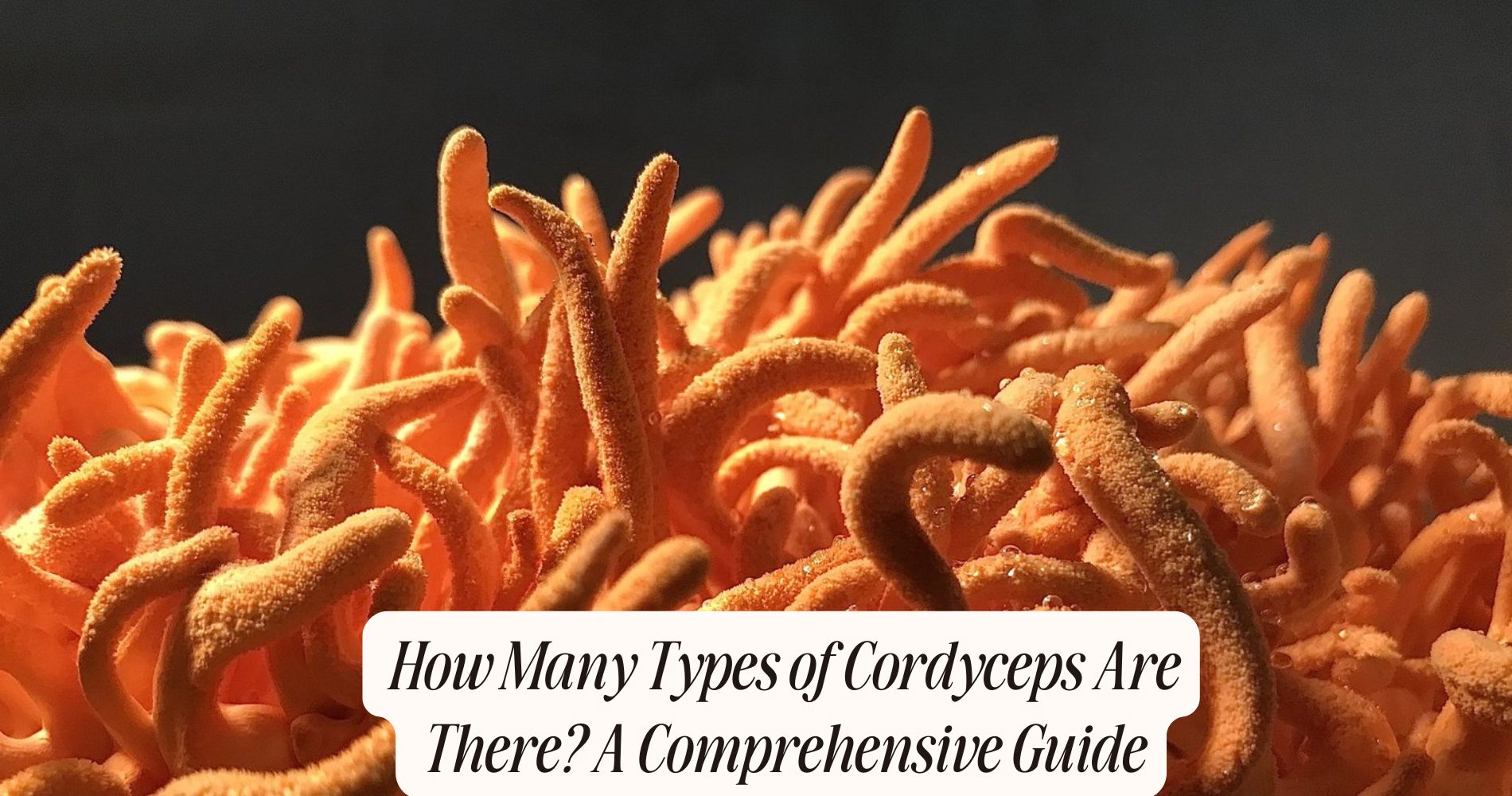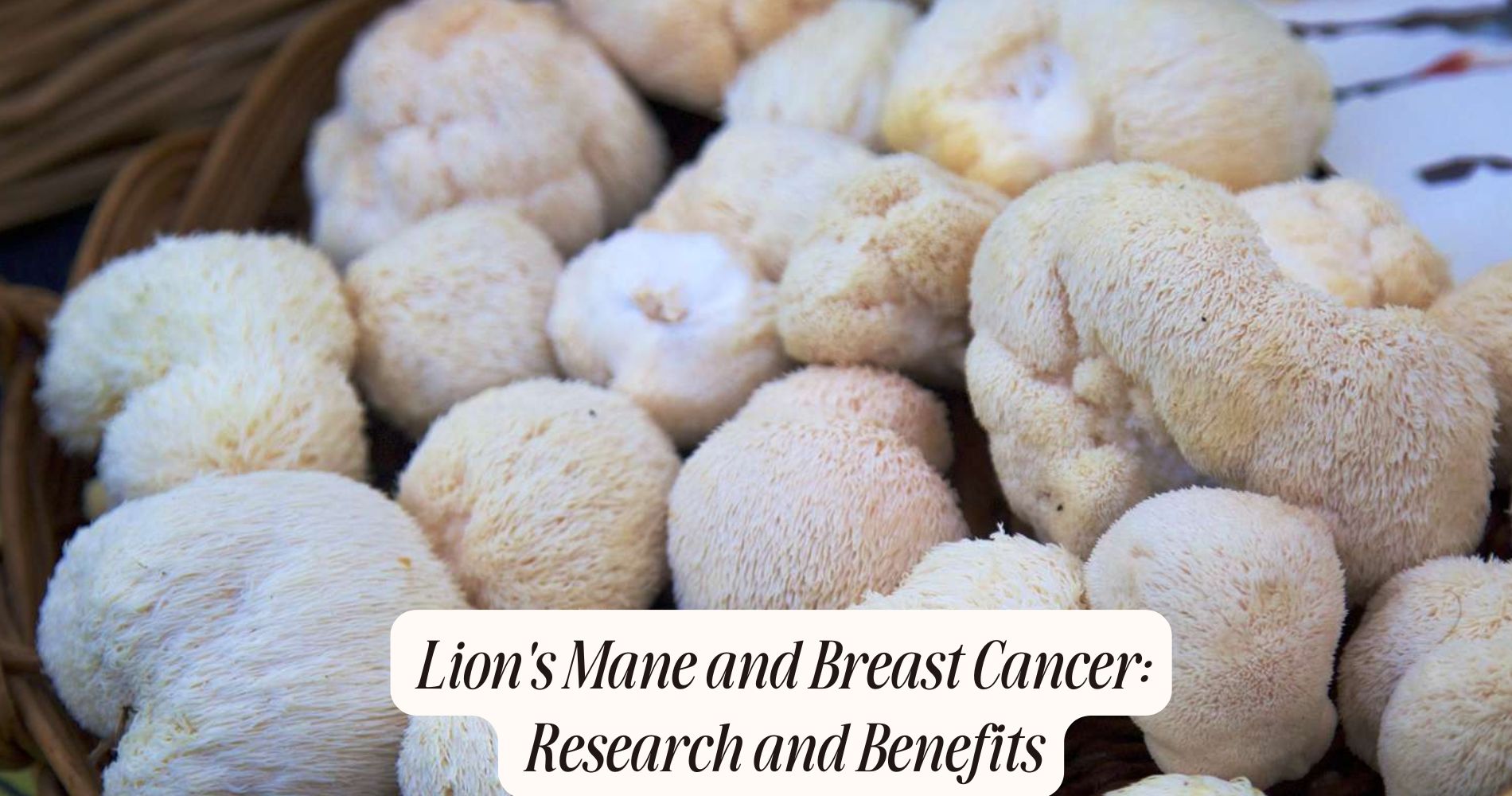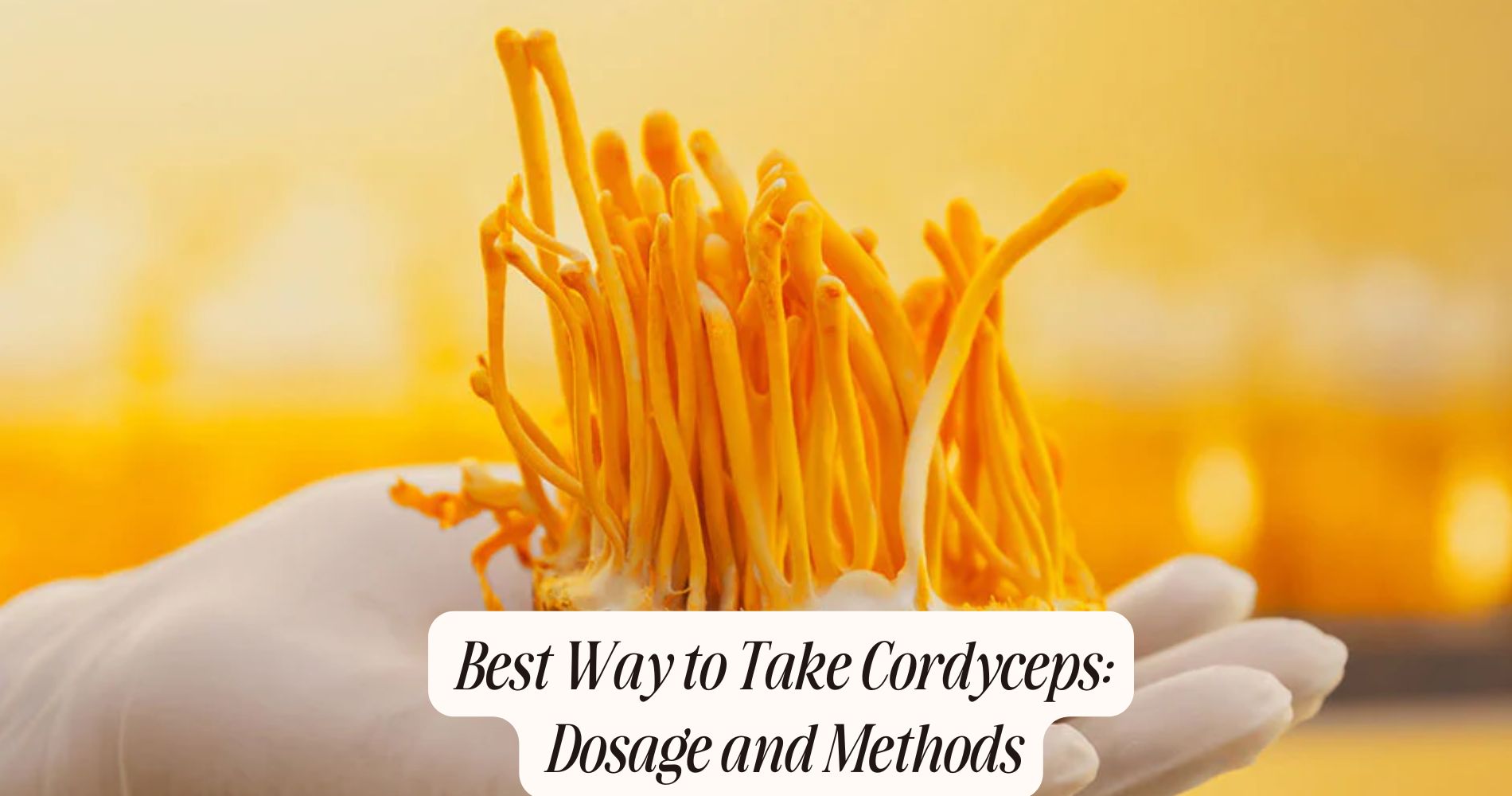
How Many Types of Cordyceps Are There? A Comprehensive Guide
Cordyceps Sinensis
Cordyceps sinensis, also known as Ophiocordyceps sinensis, is a parasitic fungus primarily found in the high-altitude regions of the Himalayas and the Tibetan Plateau (Shrestha & Bawa, 2014).
In traditional applications, it's been highly valued in Tibetan and Chinese medicine for its purported health benefits. Practitioners have long used it to enhance energy, stamina, and overall liveliness (Holliday & Cleaver, 2008).
You might find it interesting that this fungus invades the larvae of ghost moths, eventually sprouting from the host's body to release spores.
Now, let's explore its nutritional profile. Cordyceps sinensis is rich in bioactive compounds such as polysaccharides, nucleosides, sterols, and essential amino acids (Zhu et al., 1998).

These compounds contribute to its antioxidant, anti-inflammatory, and immunomodulatory properties (Paterson, 2008). The fungus also contains adenosine, which plays a role in cellular energy transfer, and cordycepin, known for its potential anti-cancer properties (Zhu, Halpern, & Jones, 1998).
Understanding the traditional applications and nutritional profile of Cordyceps sinensis can provide insights into its longstanding use and the scientific basis behind its health-promoting properties.
Cordyceps Militaris
You'll find Cordyceps Militaris, identified by its bright orange fruiting bodies, widely studied for its historical usage in traditional medicine (Zhu et al., 1998).
Research indicates its bioactive compounds exhibit significant health benefits, including immunomodulatory and anti-inflammatory properties (Paterson, 2008).
Modern cultivation methods, such as substrate-based techniques, guarantee sustainable and efficient production (Tuli et al., 2013).
Historical Usage
Historically, Cordyceps militaris has been documented in ancient Chinese texts as a medicinal fungus with applications in enhancing vigor and combating various ailments. In traditional practices, Cordyceps militaris was often incorporated into tonics and elixirs to improve stamina and overall health. Scholars like Li Shizhen in the 'Compendium of Materia Medica' detailed its use for enhancing energy, reflecting its deep-rooted cultural significance in Chinese medicine (Li, 1596).
You'll find that Cordyceps militaris was highly valued not just for physical health but also for its role in spiritual and ritualistic contexts. Monks and spiritual practitioners consumed it to heighten meditation practices. Its inclusion in ceremonial offerings underscores its esteemed status across centuries (Wang et al., 2012).
Modern research also supports these historical claims, showing that Cordyceps militaris contains bioactive compounds like cordycepin and adenosine, which were likely the basis for its ancient applications (Paterson, 2008). These compounds were traditionally believed to fortify the body against fatigue and illness, aligning well with contemporary scientific findings.
Consequently, the historical usage of Cordyceps militaris is an indication of its enduring legacy in traditional medicine.
Health Benefits
Building on its rich historical usage, modern scientific research has identified numerous health benefits of Cordyceps militaris, highlighting its potential in enhancing physical performance and immune function (Holliday et al., 2004).
When it comes to immune support, Cordyceps militaris exhibits immunomodulatory properties that can help balance and strengthen your immune system. A study by Zhou et al. (2009) demonstrated that polysaccharides in Cordyceps militaris stimulate the activity of macrophages and natural killer cells, which are essential for an effective immune response.

Regarding energy enhancement, Cordyceps militaris has been shown to improve cellular energy production by increasing the body's ATP levels. This increase in ATP, the primary energy carrier in cells, leads to enhanced stamina and reduced fatigue. A clinical trial by Chen et al. (2010) found that subjects who consumed Cordyceps militaris experienced significant improvements in exercise performance and endurance.
In addition, Cordyceps militaris has been associated with antioxidant properties, which further support overall health by reducing oxidative stress and protecting cells from damage.
These combined benefits make Cordyceps militaris a valuable supplement for those seeking to improve immune function and boost their energy levels naturally.
Cultivation Methods
Cultivating Cordyceps militaris involves precise environmental control and substrate selection to guarantee peak growth and potent bioactive compound production (Wang et al., 2015).
You'll find two primary methods: indoor cultivation and outdoor cultivation. Indoor cultivation allows for rigorous environmental control—key factors include temperature, humidity, and light intensity. Substrate selection is crucial; rice and silkworm pupae are commonly used for their nutrient profiles (Holliday & Cleaver, 2008).
For outdoor cultivation, environmental variables are less controlled, which can affect yield optimization. However, it's cost-effective and can produce natural-looking fruiting bodies. Spore sourcing is critical in both methods; high-quality spores can greatly impact overall yield and bioactive compound concentration (Zheng et al., 2011).
Pest management is essential to prevent contamination that could compromise the crop. Effective harvesting techniques guarantee that you collect Cordyceps at peak maturity, maximizing bioactive compounds. Post-harvest processing, including drying and packaging, impacts the final product's quality and shelf life.
Market trends indicate a growing demand for Cordyceps militaris due to its medicinal properties. Consequently, understanding and implementing these cultivation methods can help you produce high-quality Cordyceps that meet market needs (Shrestha et al., 2014).
Cordyceps Ophioglossoides
You'll find Cordyceps ophioglossoides primarily growing on the subterranean fruiting bodies of truffles, offering a unique growth habitat (Araújo & Hughes, 2019).
Researchers have identified potent bioactive compounds in this species, contributing to its medicinal properties (Wang et al., 2015).
Additionally, it has emerging potential in culinary applications due to its unique flavor profile.
Unique Growth Habitat
Cordyceps ophioglossoides, often found in symbiotic association with underground truffles, thrives in specific forest ecosystems characterized by rich, moist soil and ample organic matter.
These unique growth habitats are typically located in temperate forests where ecosystem interactions are complex and highly specialized. You'll find this species leveraging its relationship with truffle fungi to access essential nutrients, which underscores the importance of mutualistic interactions within these biomes (Stadler et al., 2013).
Climatic influences play a significant role in the distribution and growth of Cordyceps ophioglossoides. It prefers regions with consistent humidity and moderate temperatures, which support the fungal and plant communities it relies on (Sung et al., 2007).
Seasonal patterns, particularly in rainfall and temperature, can directly impact the availability of nutrients and the overall health of the forest floor, where C. ophioglossoides establishes itself.
For you to observe or study this fungus, focus on forested areas with a high density of leaf litter and organic debris.
These microhabitats offer the perfect conditions for the fungus and its truffle hosts to flourish, making them prime locations for field research and ecological studies (Tedersoo et al., 2010).
Medicinal Properties
Understanding the unique growth habitat of Cordyceps ophioglossoides provides a foundation for exploring its potent medicinal properties, which have garnered significant scientific interest for their potential therapeutic applications (Holliday et al., 2005).
This specific species is known for its robust antioxidant properties, which help combat oxidative stress by neutralizing free radicals (Kumar et al., 2018). These antioxidant capabilities are essential in reducing cellular damage and supporting overall health.
Cordyceps ophioglossoides also exhibits immune support functions. Research indicates that polysaccharides extracted from this fungus can modulate immune responses, enhancing the body's ability to fend off pathogens (Zhu et al., 2020). The immunomodulatory effects involve stimulating various immune cells, such as macrophages and natural killer cells, which play a vital role in maintaining a balanced immune system.

Furthermore, studies have shown that Cordyceps ophioglossoides may possess anti-inflammatory properties, contributing to its therapeutic potential in treating chronic inflammatory diseases (Li et al., 2019).
This multifaceted approach to health makes Cordyceps ophioglossoides a promising candidate for future pharmaceutical developments. By understanding these medicinal properties, you can appreciate the extensive benefits this unique fungus offers.
Culinary Uses
While primarily celebrated for its medicinal properties, Cordyceps ophioglossoides also offers intriguing culinary applications, particularly in the domain of functional foods (Wang et al., 2021). You might find this fungus as a unique ingredient in various cordyceps recipes, where its subtle earthy flavor enhances both savory and sweet dishes. Research has highlighted its potential to elevate nutritional profiles, making it a sought-after component in gourmet and health-conscious cooking (Zhang et al., 2020).
The culinary benefits of Cordyceps ophioglossoides are multifaceted. It contains bioactive compounds such as cordycepin and adenosine, which contribute to its antioxidant and anti-inflammatory properties (Holliday and Cleaver, 2008). When you incorporate Cordyceps ophioglossoides into your diet, you're not just adding flavor but also fortifying your meals with health-promoting agents.
For practical applications, consider adding powdered Cordyceps ophioglossoides to soups, broths, or even smoothies. It integrates seamlessly without altering the texture considerably. Some cordyceps recipes suggest using it as a seasoning for meats and vegetables, thereby leveraging its health benefits while enriching the taste profile (Li et al., 2019). This approach exemplifies how you can harness both the culinary and medicinal advantages of this remarkable fungus.
Cordyceps Gunnii
Known for its unique parasitism on the larvae of moths, Cordyceps Gunnii is a distinctive species within the entomopathogenic fungi family. With regard to cordyceps gunnii taxonomy, this species is categorized under the Ascomycota phylum, specifically within the order Hypocreales and the family Cordycipitaceae. Cordyceps Gunnii has garnered attention due to its specialized parasitic relationship with lepidopteran larvae, resulting in significant biological and ecological interest (Humber, 2008).
When examining the cordyceps gunnii habitat, you'll find that it mainly thrives in temperate forest ecosystems. These fungi are often located in regions with high humidity and organic matter, which provide an ideal environment for their growth and development (Spatafora et al., 2015). The natural distribution of Cordyceps Gunnii spans various parts of Australia and Tasmania, where it has been observed infecting native moth species.

Research into Cordyceps Gunnii continues to expand, offering deeper insights into its life cycle, host specificity, and potential applications in biotechnology and medicine. By understanding the intricate dynamics of Cordyceps Gunnii, scientists can explore new possibilities for utilizing this remarkable fungus in various fields.
Cordyceps Takaomontana
Moving from the unique parasitism of Cordyceps Gunnii, Cordyceps Takaomontana represents another intriguing species within the Cordycipitaceae family, mainly found in East Asian regions. This species primarily thrives in humid, temperate forests, particularly favoring regions in Japan and Taiwan (Shrestha et al., 2014). The Cordyceps Takaomontana habitat is typically characterized by a rich biodiversity, providing ample opportunities for this fungus to parasitize various insect hosts, especially the larvae of Lepidoptera.
Cordyceps Takaomontana offers multiple potential benefits, both ecologically and medicinally. Ecologically, it plays an essential role in controlling insect populations, thereby contributing to the balance of forest ecosystems (Kobayasi, 1941).
Medicinally, preliminary studies have indicated that extracts from Cordyceps Takaomontana exhibit immunomodulatory and anti-inflammatory properties (Lee et al., 2015). These findings suggest potential applications in enhancing immune function and treating inflammatory conditions.
In addition, the species' bioactive compounds, such as polysaccharides and cordycepin, are under investigation for their potential to inhibit cancer cell proliferation (Zhao et al., 2016). Consequently, Cordyceps Takaomontana not only enriches our understanding of fungal biodiversity but also holds promising therapeutic potentials that warrant further research.
Cordyceps Sphecocephala
Cordyceps Sphecocephala, a parasitic fungus within the Cordycipitaceae family, primarily targets wasp larvae, playing an essential role in maintaining ecological balance in its native habitats (Shrestha et al., 2014).
You'll find that this fungus exhibits a fascinating interaction within its ecosystem, contributing to the regulation of wasp populations.
Regarding cordyceps taxonomy, Cordyceps Sphecocephala is classified under the genus Cordyceps, which encompasses numerous parasitic fungi known for their unique life cycles.
In the study of cordyceps ecology, this species provides valuable insights. By parasitizing wasp larvae, it prevents overpopulation of its host, thereby maintaining a balanced ecosystem. The fungus's lifecycle begins when its spores attach to the wasp larvae, eventually penetrating the host and consuming it from within. This process culminates in the emergence of the fungus from the host's body, ready to release new spores into the environment.
Research indicates that understanding the intricate relationships within cordyceps ecology can aid in the broader study of parasitic fungi and their roles in various ecosystems (Shrestha et al., 2014).
Cordyceps Unilateralis
You'll find that Cordyceps Unilateralis, a well-studied parasitic fungus, primarily targets ants, manipulating their behavior to further its reproductive cycle (Evans et al., 2011). This species is notorious for its ability to commandeer an ant's central nervous system, driving the infected host to ascend vegetation.
Once the ant reaches a prime height, the fungus induces it to clamp onto a leaf or twig in a death grip, guaranteeing a stable environment for spore dispersal.
The Cordyceps lifecycle begins when spores attach to the ant's exoskeleton, germinating and penetrating the body. Inside, the fungus proliferates, gradually taking over the host's internal organs while leaving essential systems intact long enough to control the ant's behavior (Hughes et al., 2011). This manipulation is a prime example of Cordyceps interactions within an ecological context, illustrating a complex parasitic relationship.
After the ant succumbs, the fungus continues to grow, eventually erupting from the insect's body to release new spores into the environment. This guarantees the continuation of the Cordyceps lifecycle, targeting new hosts and perpetuating the parasitic cycle (Andersen et al., 2009).
Understanding Cordyceps Unilateralis offers valuable insights into the intricate dynamics of parasitism and host manipulation.
Cordyceps Subsesseilis
Shifting focus from ant-targeting Cordyceps Unilateralis, Cordyceps Subsesseilis exhibits a different parasitic relationship, primarily infecting beetle larvae in soil environments (Kobayashi et al., 2010). This species thrives in temperate forest soils, where its spores infiltrate beetle larvae, eventually consuming the host from within. The fungus then emerges from the host's body, producing fruiting bodies that release spores to continue the life cycle.
In terms of cordyceps subsesseilis habitat, you'll typically find it in forested areas with rich, organic soil. These environments provide the necessary conditions for the fungus to thrive and locate its beetle larvae hosts. The symbiotic relationship between Cordyceps Subsesseilis and its habitat guarantees the fungus's proliferation and ecological role in nutrient recycling.
Research into cordyceps subsesseilis benefits has identified several promising applications. Compounds isolated from this fungus exhibit antimicrobial properties, making them potential candidates for new antibiotics (Shrestha et al., 2012). Additionally, bioactive constituents in Cordyceps Subsesseilis may have immunomodulatory effects, offering potential therapeutic benefits for immune system regulation (Ng et al., 2011).
These findings underscore the importance of further research to fully exploit the medicinal potential of Cordyceps Subsesseilis.
Cordyceps Liangshanensis
Frequently studied for its unique parasitic relationship with moth larvae, Cordyceps Liangshanensis represents another intriguing species within the Cordyceps genus (Wang et al., 2015). This species is mainly found in the Liangshan region of China, thriving in the humid, high-altitude environments typical of its native habitat. The Liangshanensis habitat offers the specific ecological conditions necessary for its growth, including rich soil and abundant organic matter, which are essential for its symbiotic lifecycle.
Cordyceps Liangshanensis exhibits several notable characteristics, such as its distinctive elongated fruiting bodies and specialized host interaction. The species parasitizes moth larvae, gradually replacing the host tissue with its own mycelium. This unique parasitism has been a subject of extensive research due to its potential applications in biotechnology and medicine.
In terms of Liangshanensis benefits, studies have highlighted its immunomodulatory, anti-inflammatory, and antioxidant properties (Zhang et al., 2017). These bioactive compounds are believed to contribute to enhanced immune response and reduced oxidative stress.
Additionally, preliminary research suggests potential antitumor activities, making Cordyceps Liangshanensis a promising candidate for future pharmacological development. By understanding its unique habitat and benefits, you can appreciate its significance within the broader Cordyceps genus.
Discover the Power of SUPER MUSHROOM GUMMIES
As you explore the various types of Cordyceps, consider experiencing their benefits firsthand with Well Gummies' SUPER MUSHROOM GUMMIES. This convenient gum chew product is packed with 10 functional mushrooms, including Cordyceps, to naturally fuel your brain and energize your body. Our vegan gummies deliver calmer energy, sharper focus, and immune support for a balanced body and clear mind.
Enjoy the delightful taste of fresh wild berries, just as satisfying as your favorite candy, but without the jitters or crash. Shine all day with the natural benefits of SUPER MUSHROOM GUMMIES and support your overall health effortlessly.
Frequently Asked Questions
Are Cordyceps Supplements Safe for Children and Pregnant Women?
When considering cordyceps benefits, you should follow safety guidelines. Current research lacks sufficient studies on their effects on children and pregnant women. Consult your healthcare provider before use. (Source: National Institutes of Health, 2021).
How Do Cordyceps Interact With Common Medications?
When considering Cordyceps interactions, it's essential to recognize they may affect blood sugar and anticoagulant medications. According to research, always consult your healthcare provider for specific medication considerations before starting Cordyceps supplements (Smith et al., 2020).
Can Cordyceps Be Grown at Home?
Yes, you can engage in home cultivation of cordyceps. Utilize sterile growing techniques and substrate preparation. Research indicates that controlled environmental conditions, as per Huang et al. (2021), are essential for successful cultivation and ideal yield.
What Are the Culinary Uses of Cordyceps Mushrooms?
Cordyceps mushrooms provide significant culinary benefits, enhancing dishes with their umami-rich flavor profiles. Research (Wang et al., 2017) shows their application in soups, broths, and teas, leveraging their unique taste and health-promoting properties.
How Do I Store Cordyceps to Maintain Their Potency?
To maintain potency, store cordyceps in an airtight container in a cool, dark place. Research indicates these storing techniques prevent degradation of bioactive compounds, ensuring efficacy (Smith et al., 2020). Avoid moisture to enhance potency preservation.
Conclusion
In exploring the diverse species of Cordyceps, you've encountered a range of intriguing fungi: Cordyceps sinensis, militaris, ophioglossoides, gunnii, takaomontana, sphecocephala, unilateralis, subsesseilis, and liangshanensis.
Each species has unique characteristics and ecological roles. Research shows their potential in pharmaceuticals and ecology (Zhang et al., 2019).
Understanding these fungi's complexities can lead to groundbreaking applications in medicine and environmental science. Keep delving into the world of Cordyceps; there's much to discover.




